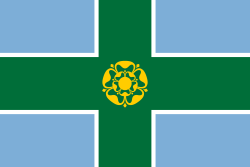History
In 1086, following the Norman Conquest, the manor of Sudbury was listed in the Domesday Book.
The Vernon family came to Sudbury as a result of the 16th-century marriage of the Sudbury heiress Ellen Montgomery to Sir John Vernon (d.1545), a son of Sir Henry Vernon of Haddon Hall in Derbyshire. [3]
The present house at Sudbury was built shortly after the restoration of King Charles II, between 1660 and 1680 by George Vernon, grandfather of George Venables-Vernon, 1st Baron Vernon. [3] George Vernon used his new-found wealth from marrying Northamptonshire heiress Margaret Onley to build a grand new mansion on the site of a smaller house. He kept meticulous accounts of the building project, and because there is no record of any payment to an architect, historians surmise that George designed Sudbury Hall himself. [4] George Vernon also established the Estate village close to the Hall to provide housing for his servants, labourers and tradesmen. The buildings in the village still survive intact today. [3]
Sudbury Hall was leased for three years from 1840 by Queen Adelaide, the widow of William IV. The east wing was added by George Devey in 1876–83. [1] By the late 19th century, the extent of the Sudbury Estate stretched from Cubley down to Marchington in Staffordshire. [3]
In 1916, George Venables-Vernon, 8th Baron Vernon, died aged 26 in Malta from an illness contracted while in service as an officer in World War I. As a result, the Sudbury estate was subject to Death duties, the taxation which had been introduced in 1894 by the Liberal Government. As with many other large estates across Britain, this increased financial burden compelled Francis Venables-Vernon, 9th Baron Vernon, to sell off tracts of land and some of the contents of Sudbury Hall. In the 1930s and 1940s, the 9th Lord was able to buy back some of this land to provide social housing in Sudbury village. [3]
During World War II, a United States Army Air Forces hospital was based in Sudbury Park, close to RAF Sudbury. The land was purchased by the government in 1948 and converted into HM Prison Sudbury, with a housing estate for prison officers. [3]
National Trust
Death duties continued to burden the Vernon family, and in 1967, Sudbury Hall and its principal contents along with part of the gardens and parkland, was transferred by John Venables-Vernon, 10th Baron Vernon via the National Land Fund to the National Trust, in part payment of death duties. The remainder of the Sudbury Estate is still held by Vernon descendants. [4] [3]
In 2020 Sudbury Hall closed to the public for renovations, during which the National Trust consulted 100 child "ambassadors" to redesign the visitor experience for children. It reopened in October 2022, rebranded as The Children’s Country House at Sudbury, equipped with a dressing up and dancing area, a mirror ball, a neon sign with the words "Party like it’s 1699", an escape room experience and humorous speech bubbles hung next to portraits. [6] The revised visitor experience has been criticised by the Vernon Family; Joanna FitzAlan Howard, daughter of the 10th Baron Vernon accused the National Trust of "dumbing down" by turning her ancestral home into "a child-centred theme park". [7] The National Trust have stated that the new experience offers "new ways for children to learn about the history of Sudbury Hall" and that the speech bubbles inform children about "hidden symbolism in historic portraits". [8] [9] The changes have also been criticised by the pressure group Restore Trust for discouraging adult visitors unaccompanied by children, and for removing the house contents to make way for "fun active games and activities". [10] In May 2023 the Children’s Country House at Sudbury was awarded Permanent Exhibition of the Year at the Museum and Heritage Awards 2023. Judges expressed the view that the redesign of Sudbury Hall offered a "participatory and imaginative new bold approach to interpreting historic houses and heritage". [11] [12]
Architecture
Sudbury Hall dates from the Restoration era, but George Vernon's building is based on a Jacobean design, with its ornate Great Staircase and Long Gallery. Notably, the state rooms are located on the west side of the building and the servants' quarters on the east side, a traditional layout preferred by Tudor architects. [1] Architectural historian Cherry Ann Knott has suggested that the design of the hall was based on Crewe Hall in Cheshire, which stands around 1.5 miles from Haslington Hall, where George Vernon was born. [13]
The house is a two-storey red brick building fronted with a Baroque main entrance porch, with two levels of paired columns, each surmounted with a pediment. The carvings above the porch were sculpted by William Wilson. [1]
Interior
The interior of the house was completed in 1691. There have been a number of small alterations in the 18th and 19th centuries, and the interior was restored 1969-1971 by John Beresford Fowler. The Great Staircase, designed by Edward Pierce, dates from c.1676 and is considered to be one of the finest Restoration staircases in Britain. It is noted for its white-painted balustrade with luxuriant, carved foliage. The landing ceiling is adorned with ornate plasterwork by Robert Bradbury and James Pettifer (1675) and ceiling paintings of mythological scenes by Louis Laguerre. Other plasterwork within the house was designed by Pettifer, Bradbury and Samuel Mansfield of Derby. Of particular note in the drawing room is an ornately carved overmantel by Grinling Gibbons. [1]
Between c.1872 and 1880, architect George Devey significantly modified and extended an early 19th-century servants' east wing to Sudbury Hall; this now houses the National Trust Museum of Childhood. [1]
This page is based on this
Wikipedia article Text is available under the
CC BY-SA 4.0 license; additional terms may apply.
Images, videos and audio are available under their respective licenses.
















